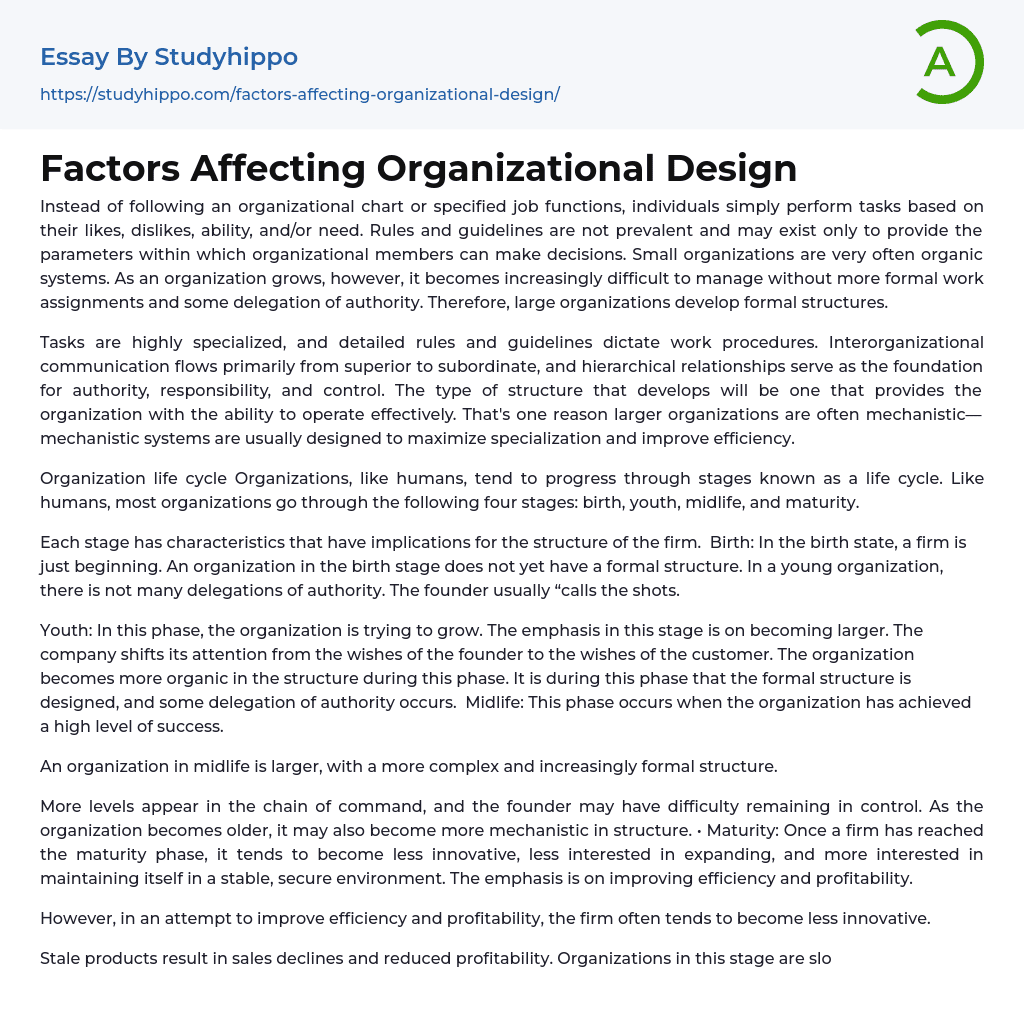Instead of following an organizational chart or specified job functions, individuals simply perform tasks based on their likes, dislikes, ability, and/or need. Rules and guidelines are not prevalent and may exist only to provide the parameters within which organizational members can make decisions. Small organizations are very often organic systems. As an organization grows, however, it becomes increasingly difficult to manage without more formal work assignments and some delegation of authority. Therefore, large organizations develop formal structures.
Tasks are highly specialized, and detailed rules and guidelines dictate work procedures. Interorganizational communication flows primarily from superior to subordinate, and hierarchical relationships serve as the foundation for authority, responsibility, and control. The type of structure that develops will be one that provides the organization with the ability to operate effectively.
...That's one reason larger organizations are often mechanistic—mechanistic systems are usually designed to maximize specialization and improve efficiency.
Organization life cycle Organizations, like humans, tend to progress through stages known as a life cycle. Like humans, most organizations go through the following four stages: birth, youth, midlife, and maturity.
Each stage has characteristics that have implications for the structure of the firm. Birth: In the birth state, a firm is just beginning. An organization in the birth stage does not yet have a formal structure. In a young organization, there is not many delegations of authority. The founder usually “calls the shots.
Youth: In this phase, the organization is trying to grow. The emphasis in this stage is on becoming larger. The company shifts its attention from the wishes of the founder to the wishes of the customer. The organization becomes more organic in the structure during thi
phase. It is during this phase that the formal structure is designed, and some delegation of authority occurs. Midlife: This phase occurs when the organization has achieved a high level of success.
An organization in midlife is larger, with a more complex and increasingly formal structure.
More levels appear in the chain of command, and the founder may have difficulty remaining in control. As the organization becomes older, it may also become more mechanistic in structure. • Maturity: Once a firm has reached the maturity phase, it tends to become less innovative, less interested in expanding, and more interested in maintaining itself in a stable, secure environment. The emphasis is on improving efficiency and profitability.
However, in an attempt to improve efficiency and profitability, the firm often tends to become less innovative.
Stale products result in sales declines and reduced profitability. Organizations in this stage are slowly dying. However, maturity is not an inevitable stage.
Firms experiencing a decline in maturity may institute the changes necessary to revitalize. Although an organization may proceed sequentially through all four stages, it does not have to. An organization may skip a phase, or it may cycle back to an earlier phase. An organization may even try to change its position in the life cycle by changing its structure.
As the life-cycle concept implies, a relationship exists between an organization's size and age. As organizations age, they tend to get larger; thus, the structural changes a firm experiences as it gets larger and the changes it experiences as it progresses through the life cycle are parallel. Therefore, the older the organization and the larger the organization, the greater its need for more
structure, more specialization of tasks, and more rules. As a result, the older and larger the organization becomes, the greater the likelihood that it will move from an organic structure to a mechanistic structure.
Strategy How an organization is going to position itself in the market in terms of its product is considered its strategy. A company may decide to be always the first on the market with the newest and best product (differentiation strategy), or it may decide that it will produce a product already on the market more efficiently and more cost-effectively (cost-leadership strategy). Each of these strategies requires a structure that helps the organization reach its objectives. In other words, the structure must fit the strategy.
Companies that want to be the first on the market with the newest and best product probably are organic because organic structures permit organizations to respond quickly to changes. Companies that elect to produce the same products more efficiently and effectively will probably be mechanistic. Environment The environment is the world in which the organization operates, and includes conditions that influence the organization such as economic, social-cultural, legal-political, technological, and natural environment conditions.
- Chief Executive Officer essays
- Convenience Store essays
- Firm essays
- Training And Development essays
- Unilever essays
- Variable Cost essays
- Virgin Group essays
- Bargaining essays
- Entity essays
- Pest analysis essays
- Being A Leader essays
- Servant Leadership essays
- Leadership Experience essays
- Leadership Qualities essays
- John Locke essays
- 9/11 essays
- A Good Teacher essays
- A Healthy Diet essays
- A Modest Proposal essays
- A&P essays
- Academic Achievement essays
- Achievement essays
- Achieving goals essays
- Admission essays
- Advantages And Disadvantages Of Internet essays
- Alcoholic drinks essays
- Ammonia essays
- Analytical essays
- Ancient Olympic Games essays
- APA essays
- Arabian Peninsula essays
- Argument essays
- Argumentative essays
- Art essays
- Atlantic Ocean essays
- Auto-ethnography essays
- Autobiography essays
- Ballad essays
- Batman essays
- Binge Eating essays
- Black Power Movement essays
- Blogger essays
- Body Mass Index essays
- Book I Want a Wife essays
- Boycott essays
- Breastfeeding essays
- Bulimia Nervosa essays
- Business essays
- Business Process essays
- Canterbury essays




